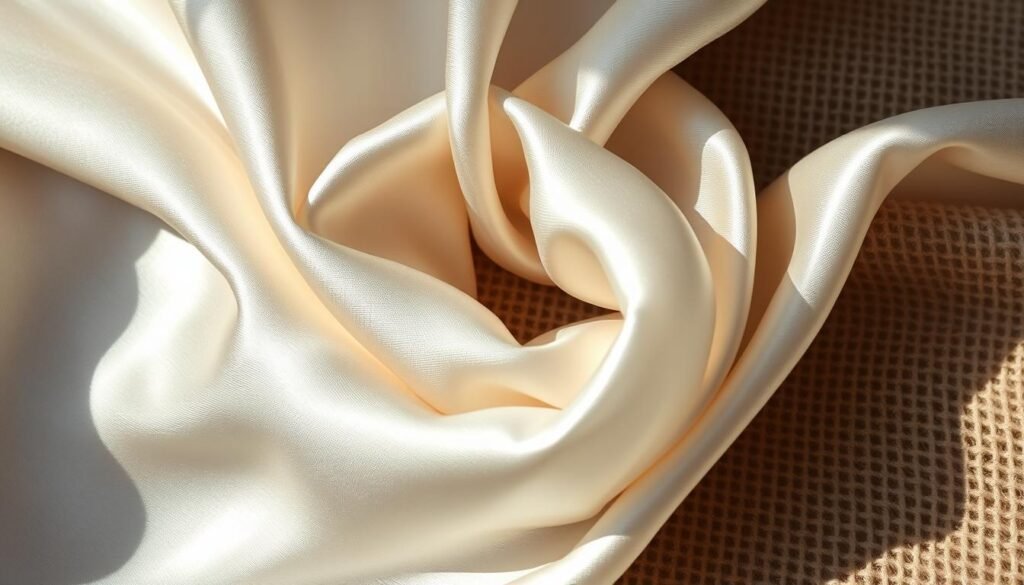In today’s world, it’s hard to know if we’re buying real silk. Silk’s timeless beauty makes it popular, but fake versions are hard to spot. Luckily, there are easy ways to tell if a fabric is truly silk or not. Let’s learn how to spot the real silk!
Key Takeaways
- Silk has been prized for its luxurious qualities since ancient times, with methods to identify it dating back to the Silk Route era1
- Factors like price, appearance, and burning characteristics can help distinguish real silk from synthetic imitations2
- Proper care and handling are essential to preserving the integrity and longevity of silk fabrics3
- India is a major producer of high-quality silk, challenging the misconception that only Chinese silk is superior1
- Reliable silk identification tests, such as the burn test and ring test, can be performed at home to verify authenticity32,
What Is Silk and Why Is It So Valuable?
Silk is a special natural protein fiber. It has been made into luxurious textiles for over 5,000 years. It started in ancient China4. This fabric is called the “queen of fabrics” because it is very soft, strong, and shiny.
Its unique structure and how it is made make it very valuable. This is why people love to use it in clothes, accessories, and for their homes.
Silk’s History and Significance
The story of silk is linked to ancient China’s rise. It started in China about 4,000 years ago. For a long time, it was a secret4.
Then, the Silk Road started around 500 BC. This let other cultures see the beauty and skill of silk4.
Properties That Make Silk Luxurious
Silk is loved for its special qualities. It is hypoallergenic and elastic, making it perfect for many products4. It also has a shine and feel that no synthetic fabric can match4.
Real silk has a unique texture. Handwoven ones have small differences, making each piece special5.
Silk is strong and flexible, making it luxurious. It is more tear-resistant than fake ones4. You can thread it through a wedding ring to check if it’s real5. Rubbing it makes it warm, which is another sign of real silk5.
Silk’s amazing qualities, history, and beauty make it very valuable. It is in high demand and costs a lot in the textile market4.
The Price Test: A Clue to Authenticity
Looking for real silk? Check the price first. Real silk is very expensive to make, with prices going up lately6. So, real silk items and accessories usually cost more than fake ones7.
The price of silk changes a lot. It depends on the type of silk, how it’s made, and where it comes from6. For example, twill silk scarves are for formal events. Satin scarves are for evenings because they’re soft and delicate6. Crepe silk is light and breathable, perfect for everyday wear6. The shine, feel, and weight of the silk also change its price6.
Some sellers even sell fake fur as real fur, so be careful when buying luxury items7. By looking at the price and other signs, you can tell real silk from fake. This helps you make a smart choice when buying this luxurious fabric67.
| Silk Scarf Type | Characteristics | Typical Use |
|---|---|---|
| Twill | Lustrous sheen, strong structure | Formal occasions |
| Satin | Glossy finish, delicate texture | Evening wear |
| Crepe | Lightweight, breathable | Casual wear |
| Georgette | Sheer, lightweight | Scarves and shawls |
| Habotai | Fine, smooth fabric | Scarves and shawls |
| Chiffon | Sheer, lightweight | Scarves and shawls |
| Organza | Sheer, stiff fabric | Scarves and shawls |
“Real fur usually costs significantly more than faux fur, and in some cases, real fur is sold as fake fur.”7
The price of silk is a good way to tell if it’s real or fake. Knowing what affects silk prices and spotting fakes helps you make good choices when buying silk. This way, you can be sure you’re getting the real, quality silk you want678.
Satin vs. Silk: Understanding the Difference
Satin and silk can be confusing for many when it comes to fabrics. Satin is actually a weave, not a material. It can be mixed with silk, like in crepe-backed satin, but it’s not always silk9.
Make sure you’re buying real silk by looking for labels that say “silk” or “silk satin.” Real silk is different from fake or synthetic ones10.
| Characteristic | Natural Silk | Synthetic Silk |
|---|---|---|
| Luster and Sheen | Produces a slight gloss and shines in light | Dull appearance |
| Softness and Texture | Feels gentle and soft to the touch | Feels like regular cloth |
| Thermal Conductivity | Quickly assumes body temperature, feeling natural | Remains cold to the touch |
| Durability | Tough to tear | Tears easily |
| Thread Retention | Retains its thread form when pulled | Becomes fluffy when pulled |
| Cost | Typically more expensive | More affordable |
Knowing the differences between satin and silk helps you choose the right fabric. Whether you want the luxury of silk or the affordability of satin, this knowledge is key11910.
Evaluating Silk’s Appearance and Luster
Genuine silk stands out because of its shiny, shimmering look. This comes from the special structure of silk fibers. They bend light in a way that makes the fabric look colorful and bright. As you move the fabric, you should observe subtle color changes due to the way the light interacts with the silk.12
Other fabrics may look shiny, but they don’t shine like real silk. Pure silk sarees have a distinct luster and shine that cannot be replicated, with light reflecting from different angles to produce a multitude of colors.13
The Unique Shimmering Quality of Real Silk
Twill silk scarves have a lustrous sheen12, while satin silk scarves have a glossy finish12. The special way silk fibers bend light is what makes this fabric so shiny and captivating.
Observing Color Changes at Different Angles
As you move the fabric, you should observe subtle color changes due to the way the light interacts with the silk.12 This effect shows that it’s real silk and can’t be copied. Pure silk sarees are made by hand, so they might have small flaws. Fake silk sarees are made by machines and look perfect.13

“The unique way silk fibers refract light is what gives this luxurious fabric its mesmerizing, shimmering quality.”
Inspecting the Weave for Imperfections
Looking closely at the weave can tell you if a fabric is real silk. Real silk is often made by hand, which means it might have small flaws in the weave14. This is different from machine-made silk, which looks perfect and the same all over15. Even though some high-quality silk is made by machines, finding small weave differences can help spot the real deal.
Handwoven silk often has small imperfections in the weave15. These tiny flaws show the hard work that goes into making silk by hand14. On the other hand, machine-made silk looks smooth and even, without the special touch of handwork.
Checking the fabric’s texture and looking for small flaws in the weave can tell you if it’s real silk15. Using this method with other ways to check can help buyers know for sure if they’re looking at the real thing.
“Silk is a natural protein fiber, some of the oldest fibers in use. Although long prized by humans, the silk from the silkworm is not the only type of ‘natural silk’. There are several other insects that produce silk, including the Spider.” – Wikipedia
How to Tell if Fabric Is Silk: Simple Identification Methods
Identifying real silk is easy with a few simple steps. By using these methods, you can tell if a fabric is silk or not16.
First, check the price. Silk is usually more expensive than fake fabrics like polyester16. But, some natural silk might be cheaper under certain conditions.
It’s also good to know the difference between satin and silk. Satin is a weave, not just a silk type. Always look for labels that say “100% silk” or mention specific silk types like chiffon or crepe17.
Looking at the fabric’s shine and how it changes color can also help. Real silk shines and changes color in the light18. Also, look for small flaws in the weave. Handmade silk often has these imperfections18.
The burn test is a sure way to check if it’s silk. Silk will smolder and go out fast, leaving black fibers that crumble1617. Fake fabrics will burn and smell bad1617.
The Touch Test: Feeling for Warmth and Smoothness
One easy way to spot real silk is by touching it. Real silk feels soft, smooth, and almost waxy. When you rub it between your fingers, it gets slightly warm because silk keeps heat well.19 Synthetic fabrics don’t feel warm or smooth like silk does.
Silk’s Distinctive Soft and Waxy Feel
Silk’s soft and waxy feel comes from its natural protein fibers. These fibers make silk smooth and supple. When you touch silk, it feels smooth and slides easily under your fingers.
The Warmth Generated by Rubbing Silk
Rubbing silk between your fingers is another way to tell if it’s real. Silk keeps heat in, making it warm and cozy.19 Synthetic materials like polyester or nylon don’t keep heat well and feel cold.
| Fabric Characteristic | Silk | Synthetic Fabrics |
|---|---|---|
| Texture | Soft, smooth, and waxy | Stiff or slick |
| Warmth | Generates a slight warmth when rubbed | Feels cool or cold to the touch |
| Flexibility | Highly flexible and drapable | Less flexible and may crease easily |
By noticing silk’s unique feel and warmth, you can tell it apart from fake materials. The touch test is a simple way to spot real silk and avoid fakes.19
“The softness and warmth of silk are truly unparalleled. It’s a fabric that truly caresses the skin, providing a sensory experience that can’t be replicated by any synthetic material.”
Remember, the touch test is just one way to check if you’re buying real silk. Use it with other methods like the burn test and chemical checks to be sure of your silk’s quality and authenticity.
The Ring Test: Evaluating Silk’s Flexibility
Checking if silk is real can be tricky, but the silk ring test helps. It checks if the fabric is flexible and smooth, which are signs of real silk20.
To do the ring test, pull the fabric through a small ring, like a jewelry ring. Real silk goes through easily, moving smoothly. Fake fabrics might get stuck or bunch up20.
This test uses silk’s special features. Silk is very flexible and light, making it easy to move. The ring test uses these traits to tell real silk from fake20.
Watching how the fabric goes through the ring tells you a lot about it. The silk ring test is a simple way to check if something is real silk. It helps you know the true quality of silk20.

Silk looks great and lasts a long time because it’s so flexible and smooth. When silk goes through a small ring easily, it shows it’s high quality and real21.
Using the silk ring test helps you know if you’re buying real silk. This easy method is great for telling real silk from fake21.
The Burn Test: A Definitive Method
The burn test is a top way to tell if something is real silk22. You burn a small piece of fabric to see how it burns and smells. This tells you if it’s silk or not22.
Identifying Silk by Its Burning Characteristics
Real silk burns slowly and smells like burning human hair. It leaves behind a brittle, ashy piece22. This is because silk is a natural protein, unlike fake materials which melt fast and smell like plastic22.
The Bombyx Mori silkworm is often used to make silk23. Its burning traits help tell real silk from fake.
Safety Precautions for Conducting the Burn Test
Though the burn test is useful, be very careful with it22. Make sure you have water ready and test in a place with good air flow22. Also, watch out for fire risks and take steps to avoid them.
Knowing how silk burns and staying safe, you can use the burn test to check if fabric is real22. This easy method helps you make smart choices when buying or using silk.
Chemical Tests: Dissolving in Bleach
If you’re unsure if a fabric is real silk, try a scientific test. Put a small piece of the material in diluted bleach. Real silk will dissolve in bleach, but fake fibers won’t24.
This test is sure to tell you the truth, but it destroys part of the fabric. Try simpler tests like touch, burn, and ring tests first24.
Wool also dissolves in hot chlorinated bleach, so this test helps tell silk from other natural fibers25. Also, silk is soluble in hot sodium hydroxide, which is another way to check for silk25.
The bleach test is a sure way to silk authentication, but use it last. Keeping the fabric whole is often more important. Try other ways to check before using this method.
“Performing a chemical test on a fabric is the most definitive way to determine if it is genuine silk, but it comes at the cost of destroying a small portion of the material.”
Seeking Professional Evaluation
If you’re still unsure about a silk product’s realness, get help from a pro26. Experts at textile labs or silk experts can check it out with special tools and methods26. This might cost more, but it’s the best way to know for sure if it’s real silk.
Experts at silk testing labs and silk identification experts can really help26. They know how to spot real silk by its shine, feel, and how it burns26. Using their skills, you can be sure you’re buying real, quality silk.
| Service | Description | Advantages |
|---|---|---|
| Professional Silk Evaluation | Comprehensive analysis of fabric composition and quality using advanced equipment and techniques |
|
| Silk Testing Labs | Specialized facilities that offer in-depth analysis and testing of silk fabrics |
|
| Silk Identification Experts | Seasoned professionals with extensive knowledge and experience in silk evaluation |
|
While the methods in this article help, getting help from professional silk evaluation services is best26. Working with silk testing labs and silk identification experts means you can trust your silk purchases26.
Don’t think a silk product’s price means it’s real27. Real silk might cost more, but fake ones can be cheap27. So, getting a pro to check it out is the best way to know you’re getting real silk.
Conclusion
By using simple methods, you can tell if a fabric is real silk or not. Look at the price, how it looks, and how it feels. Touching and burning it can also help28. Being smart about what you buy means you get real silk that’s worth your money29.
Silk is special because it shines beautifully, feels soft, and is good for your health29. Knowing how to spot real silk helps you stay away from fake stuff. This way, you get to enjoy silk’s luxury and benefits2930.
When shopping for silk clothes, accessories, or home items, this article gives you the tools you need. You can make sure your silk buys show off your good taste and love for quality293028.
FAQ
How can I determine if a fabric is made of real silk?
To spot real silk, check the price, look at its shine, and do some hands-on tests. These include the touch and burn tests.
What makes silk such a valuable and sought-after textile?
Silk is loved for its softness, strength, and shine. It also has a rich history and cultural value from ancient China.
How can I tell if a silk product is authentic based on its price?
Silk is very expensive to make. So, real silk items cost a lot more than fake ones. If a silk item is too cheap, it’s likely not real.
Is satin the same as silk?
No, satin is a weave, not a type of fabric. While there’s satin silk, satin alone doesn’t mean it’s silk. Always look for “silk” or “silk satin” labels for real silk.
How can I identify the unique shimmering and color-shifting properties of real silk?
Real silk shines and changes colors as you move it. This is because of its special fibers that bend light. Look for these changes in color.
What should I look for in the weave of the fabric to determine if it’s made of real silk?
Handmade silk often has small flaws in the weave. Machine-made silk is smooth and perfect. Look for these differences to guess if it’s real silk.
How can I identify genuine silk by its feel and texture?
Real silk feels soft, smooth, and a bit warm. It doesn’t feel like synthetic fabrics do. This warmth and smoothness are signs of real silk.
What is the ring test for identifying silk?
The ring test is simple. Try to pass the fabric through a ring. Silk goes through easily, but fake fabrics get stuck. This shows silk’s smoothness and flexibility.
How can I perform the burn test to determine if a fabric is made of genuine silk?
The burn test is a sure way to check for silk. Burn a small piece and see how it smells and looks. Real silk burns slowly, smells like hair, and leaves behind ash.
What chemical test can I use to conclusively determine if a fabric is made of real silk?
A bleach test can tell you for sure. Silk dissolves in bleach, but not synthetic fibers. This method is sure but destroys a part of the fabric.
Where can I go to get a professional evaluation of the authenticity of a silk product?
If you’re not sure about a silk product, get help from experts. Go to textile labs or silk specialists for a detailed check-up.




